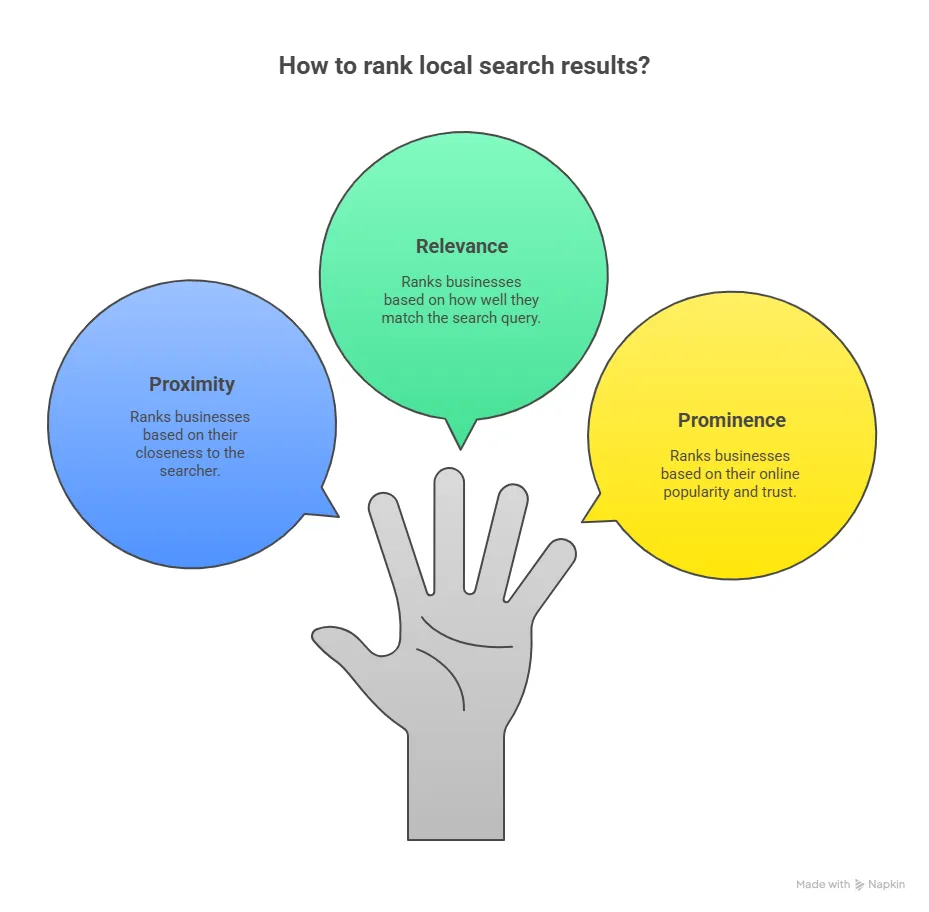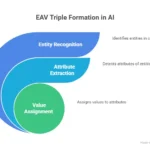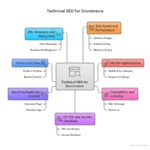Local SEO helps businesses appear in search results when people look for products or services nearby. It focuses on improving visibility for searches that include location-based intent, like “digital marketing agency in Kochi” or “best dentist near me.”
Unlike traditional SEO, which targets national or global audiences, Local SEO aims to reach potential customers within a specific geographic area. It connects online searches with real-world businesses.
Google uses signals such as the searcher’s location, business address, and local keywords to deliver relevant results. It focuses on three main factors: proximity, relevance, and prominence.
- Proximity means how close the business is to the searcher.
- Relevance checks how well the business matches the search query.
- Prominence considers how popular or trusted the business is online.
Local SEO plays a major role for small and medium businesses like shops, clinics, restaurants, agencies, and service providers. A properly optimized local presence helps them attract foot traffic, generate calls, and build trust in their region.

In the next section, we will see how Google understands local intent using entities, knowledge graphs, and contextual signals.
How Google Understands Local Intent
Google’s local search algorithm is designed to understand where a user is and what they are looking for. It does this by analyzing entities, user behavior, and contextual signals rather than just keywords.
When someone searches for “digital marketing company near me,” Google identifies two main elements:
- Entity Type: “Digital marketing company” – the business category.
- Location Intent: “Near me” – which triggers local results.
Even when a location is not mentioned directly, Google can detect implicit local intent based on the search pattern. For example, searching for “plumber” on mobile usually shows nearby plumbers because Google assumes the user needs a local service.
Google’s understanding of local intent is powered by:
- Entities and the Knowledge Graph: Each business is treated as an entity with details like name, address, phone number, and category.
- NAP Consistency: Accurate and consistent Name, Address, and Phone number across all platforms help Google trust the business entity.
- Semantic Understanding: Google connects the meaning behind search terms using semantic SEO principles, not just exact keyword matches.
- Behavioral Signals: User engagement like clicks, calls, directions, and reviews also influence how local intent is interpreted.
This process ties directly to semantic SEO and entity-based optimization, where Google builds connections between businesses, locations, and user needs.
The Google Local Pack and Map Results
When users perform a location-based search, Google often shows a special feature called the Local Pack or Map Pack. This section appears above the regular search results and displays a map with the top three nearby businesses related to the query.
For example, if someone searches for “SEO agency in Kochi,” the Local Pack will show three agencies, their ratings, opening hours, and contact details along with a map.
This area receives a large portion of clicks because it provides quick, visual, and trusted information. That’s why appearing in the Local Pack is a major goal in Local SEO.
Google decides which businesses appear there using several factors:
- Proximity: The distance between the searcher and the business.
- Relevance: How closely the business matches the search intent.
- Prominence: How popular or authoritative the business is online.
Your Google Business Profile (GBP) plays a vital role in this ranking. It provides structured data directly to Google, such as your category, location, reviews, and service details. Optimizing this profile increases your chance of appearing in both Map Pack and Google Maps searches.
In the next section, we’ll explore the key local SEO ranking factors that help businesses rank higher in both the Local Pack and organic results.
Key Local SEO Ranking Factors
Google uses many signals to decide which businesses appear in local results. While the core algorithm focuses on content and backlinks, Local SEO adds a layer of signals related to geography, trust, and user engagement.
Here are the most important factors that affect your local ranking:
1. Google Business Profile (GBP)
Your Google Business Profile is the heart of Local SEO. It helps Google understand who you are, what you do, and where you are located.
- Add complete details like business category, services, and operating hours.
- Use your main keyword naturally in the business description.
- Upload photos regularly to increase engagement.
- Keep your business open status, phone number, and address updated.
2. NAP Consistency
Your Name, Address, and Phone number should be exactly the same everywhere online.
Even small differences like “Rd.” vs “Road” can reduce Google’s trust.
Keep NAP data consistent on your website, Google Business Profile, directories, and social pages.
3. Local Citations
Citations are mentions of your business name, address, and phone on other websites, such as directories, local blogs, or chambers of commerce.
They help confirm your business entity’s legitimacy.
More high-quality and consistent citations can improve your ranking.
4. Reviews and Ratings
Positive reviews not only attract customers but also improve your local visibility.
- Respond to every review, both positive and negative.
- Ask satisfied clients to share their experience.
- Use review keywords naturally (like “best digital marketing agency in Kochi”).
5. Relevance of Content
Your website content must clearly reflect your service area and business type.
Include location-based keywords in titles, headings, and meta descriptions.
Create dedicated location pages if you serve multiple areas.
6. Prominence and Backlinks
Prominence measures how well-known your business is both online and offline.
Strong backlinks from local websites, news portals, or partners improve your reputation and visibility.
7. Schema Markup
Use LocalBusiness schema on your website to provide structured information to Google.
This helps the search engine understand your location, reviews, and services with clarity.
In the next section, we’ll go deeper into on-page optimization techniques for Local SEO and see how to design pages that attract both users and Google.
On-Page Optimization for Local SEO
On-page optimization helps search engines understand your local relevance. Every page on your website should send clear signals about your location, services, and target audience.
Here’s how to do it effectively:
1. Use Location-Based Keywords
Include your city, area, or region naturally in important elements like:
- Page title and meta description
- H1 and H2 headings
- Image alt text and captions
- URL slug (for example:
/digital-marketing-kochi/)
Avoid overstuffing. Write for humans first, and then optimize for Google.
2. Create Dedicated Location Pages
If you serve multiple areas, make a separate page for each location.
Each page should have:
- A short introduction about the area
- Services offered in that location
- Map and contact details
- Local reviews or case studies
This helps you appear for searches like “SEO expert in Kochi” or “SEO expert in Calicut.”
3. Add Embedded Google Maps
Embed a Google Map with your business pin on your contact or location page.
It signals to Google that your business is real and tied to a physical address.
4. Optimize Meta Tags and Headings
Use your main keyword along with your location in meta title, meta description, and H1 tag.
Example:
<title>SEO Agency in Kochi | Digital Marketing Experts</title>
<meta name="description" content="Looking for the best SEO agency in Kochi? We help businesses improve visibility and get more customers through proven local SEO strategies.">
<h1>Best SEO Agency in Kochi</h1>
5. Use LocalBusiness Schema
Add structured data markup to help Google understand your business details.
Example:
<script type="application/ld+json">
{
"@context": "https://schema.org",
"@type": "LocalBusiness",
"name": "Brain Cyber Solutions",
"address": {
"@type": "PostalAddress",
"streetAddress": "Smart City, Kakkanad",
"addressLocality": "Kochi",
"addressRegion": "Kerala",
"postalCode": "682030"
},
"telephone": "+91-9876543210",
"openingHours": "Mo-Fr 09:00-18:00",
"url": "https://www.braincybersolutions.com"
}
</script>
6. Optimize for Mobile Users
Since most local searches happen on mobile, make sure your website loads fast, is responsive, and has click-to-call buttons.
In the next section, we’ll cover off-page strategies and citation building, which strengthen your business presence across the web and improve local trust signals.
Off-Page and Citation Building
Off-page SEO builds trust and authority for your business outside your website. In Local SEO, it mainly focuses on citations, backlinks, and brand mentions that confirm your business as a real, active entity in a specific location.
Here’s how to do it right:
1. Build Consistent Local Citations
A citation is any online mention of your business name, address, and phone number (NAP).
Google uses citations to verify your business information and location.
- Submit your details to trusted directories like Google, Bing, Yelp, Justdial, Sulekha, and IndiaMart.
- Keep your NAP data consistent across every listing.
- Avoid duplicate or outdated listings that can confuse Google.
2. Use Local Business Directories
Get listed in location-specific directories and industry portals.
Example:
- For agencies: Clutch, DesignRush, and UpCity.
- For restaurants: Zomato and Swiggy.
- For local services: Sulekha, UrbanClap, or NearMe sites.
These help you reach a targeted audience and improve local credibility.
3. Earn Local Backlinks
Backlinks from local websites are strong ranking signals.
Ways to get them:
- Sponsor local events or community programs.
- Write guest posts for local blogs or news sites.
- Collaborate with nearby businesses for cross-promotion.
- Partner with local influencers or micro-influencers.
4. Maintain Consistency in Online Mentions
Even if your business is mentioned without a backlink, consistent mentions across multiple platforms strengthen your entity signals.
Google connects these mentions using semantic understanding, helping your business appear more prominently in local results.
5. Optimize Social Media Profiles
Social pages like Facebook, Instagram, and LinkedIn act as additional citations.
Use the same NAP format and include your website link.
Post local updates, photos, and events to build community engagement.
6. Monitor and Manage Citations
Use tools like BrightLocal, Moz Local, or Whitespark to find, fix, and track your citations.
These tools ensure your business data stays accurate across hundreds of platforms.
In the next section, we’ll see how reviews and ratings influence local SEO ranking and how to manage them effectively.
Role of Reviews and Ratings
Reviews and ratings play a critical role in Local SEO. They influence both Google’s ranking algorithm and customer trust. Positive reviews signal to Google that your business is credible, relevant, and popular.
1. Impact on Local Rankings
- Google considers the quantity, quality, and frequency of reviews when ranking businesses in the Local Pack.
- Higher ratings with recent reviews can improve your visibility in search results.
- Businesses with good reviews often get more clicks, calls, and visits.
2. Encourage Authentic Reviews
- Ask satisfied customers to leave honest feedback.
- Provide easy ways to submit reviews via email, WhatsApp, or Google Business Profile link.
- Avoid fake reviews as Google can penalize your listing.
3. Respond to All Reviews
- Replying to reviews shows you value customer feedback.
- Address negative reviews politely, offering solutions or clarifications.
- Acknowledge positive reviews to reinforce credibility.
4. Use Keywords Naturally
When responding to reviews, include location or service keywords naturally if possible.
Example: “Thank you for trusting our SEO services in Kochi. We’re glad you found our digital marketing solutions helpful!”
5. Monitor and Leverage Reviews
- Track reviews on Google Business Profile, Yelp, and other local directories.
- Showcase testimonials on your website for social proof.
- Highlight case studies or successful local projects to attract more customers.
Reviews not only improve rankings but also increase click-through rates and conversion rates from search results.
Mobile and Voice Search in Local SEO
Most local searches now happen on mobile devices and through voice assistants like Google Assistant, Siri, or Alexa. Optimizing for these is essential to capture nearby customers quickly.
1. Mobile-First Experience
- Google primarily uses mobile versions of websites for indexing and ranking.
- Ensure your website is responsive, fast-loading, and easy to navigate on smartphones.
- Include click-to-call buttons and easy-to-access contact forms for quick conversions.
2. Voice Search Optimization
- Voice searches are usually conversational and include phrases like “near me” or questions such as “Who is the best SEO agency in Kochi?”
- Use long-tail, natural language keywords in your content.
- Add FAQ sections that answer common local questions.
3. Location Signals
- Mobile devices provide precise location data to Google, making proximity a stronger ranking factor.
- Ensure your Google Business Profile, schema markup, and NAP information are accurate and consistent.
4. Structured Data for Voice Search
- Structured data helps Google pull relevant information for voice queries.
- Include business hours, services, address, and phone number in LocalBusiness schema.
5. Speed and User Experience
- Optimize images, use caching, and minimize scripts to improve page load speed.
- A smooth mobile experience increases dwell time, engagement, and ultimately local ranking.
By optimizing for mobile and voice search, businesses can reach customers exactly when they need them, driving more foot traffic and leads.
Next, we’ll cover Tracking Local SEO Performance, which shows how to measure success and identify areas for improvement.
Tracking Local SEO Performance
Measuring the effectiveness of your Local SEO efforts is essential to know what’s working and where improvements are needed. Using the right tools and metrics helps you make data-driven decisions.
1. Google Business Profile Insights
- Track metrics like views, searches, clicks, and direction requests.
- See which keywords customers used to find your business.
- Monitor engagement trends over time to optimize your profile.
2. Google Search Console (GSC)
- Analyze local search queries and impressions.
- Identify pages performing well for location-based keywords.
- Monitor click-through rates (CTR) for specific local pages.
3. Google Analytics 4 (GA4)
- Track traffic from local searches.
- See which pages drive phone calls, form submissions, or map clicks.
- Use location reports to understand where visitors come from geographically.
4. Local SEO Tools
- Tools like BrightLocal, Whitespark, and Moz Local can track:
- Citation consistency
- Local keyword rankings
- Reviews and ratings performance
- Competitor analysis
5. Key Metrics to Monitor
- Local Pack visibility: Are you appearing in the top 3 local results?
- Google Maps engagement: How many clicks, calls, or directions requests?
- Website conversions: Calls, contact form submissions, or online bookings.
- Review growth: Quantity, quality, and response rate of reviews.
Regular tracking helps you adjust strategies, fix errors, and continuously improve your local search visibility.
The Future of Local SEO
Local SEO continues to evolve as search engines become smarter and more AI-driven. Businesses that adapt early to new trends will gain a competitive edge.
1. AI and Semantic Understanding
- Google uses AI to understand context and intent beyond keywords.
- Businesses optimized with semantic SEO and entity-based signals will appear more prominently in local searches.
- Example: Google can link your business to related services or neighborhoods even without explicit keywords.
2. Hyperlocal Targeting
- Search engines are increasingly providing results based on hyperlocal signals, such as neighborhoods, landmarks, or streets.
- Optimizing for micro-locations helps small businesses capture highly targeted traffic.
3. Voice and Visual Search Growth
- Voice search continues to rise, with conversational queries becoming more common.
- Visual search allows users to find products or services using images, creating new opportunities for local businesses.
4. Reviews and Reputation Management
- User-generated content like reviews, photos, and Q&A will become even more influential.
- Google increasingly trusts authentic, recent, and relevant reviews when ranking local businesses.
5. Integration with Other Google Services
- Google Maps, Google Business Profile, and Google Ads are tightly connected.
- Businesses that maintain accurate data across all platforms will benefit from better visibility and higher CTR.
6. Linking Local SEO to Entity and Semantic SEO
- Using structured data, citations, and content that highlights your business as an entity helps Google connect you to your services, location, and customers.
- This ensures long-term visibility in evolving AI-driven local search environments.
The future of Local SEO is about combining proximity, relevance, and prominence with AI-driven understanding and semantic entity optimization. Businesses that adapt to these changes will dominate local search results.

